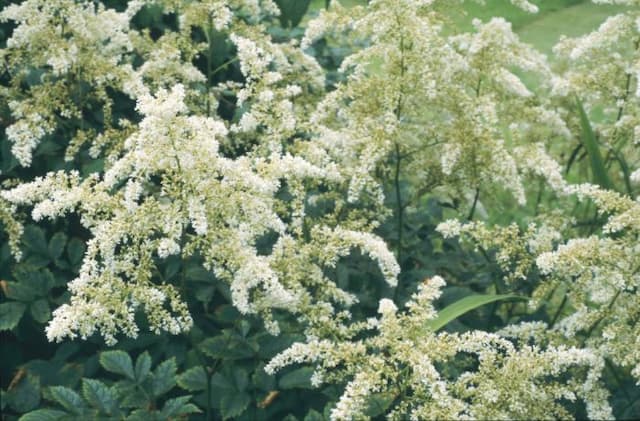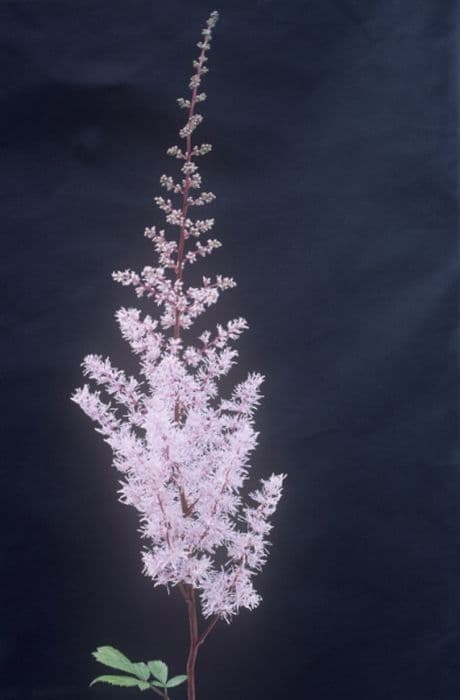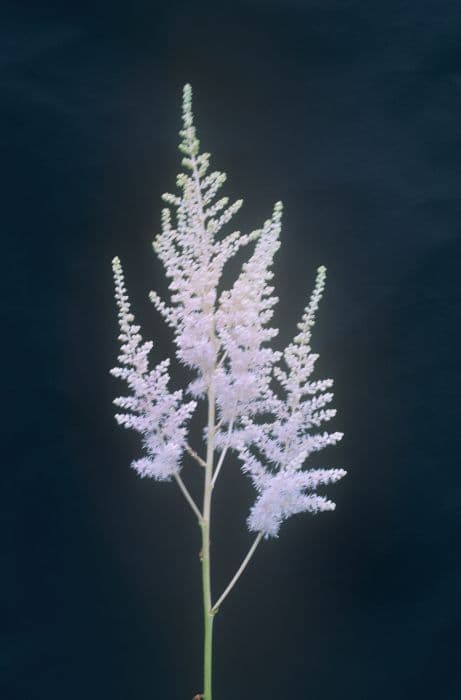False Goat's Beard Astilbe 'Europa' (japonica hybrid)

ABOUT
Astilbe 'Europa', also known as false goat's beard, is a perennial garden plant known for its attractive foliage and showy flowers. The plant features a mound of elegant, fern-like leaves that are typically deep green in color, sometimes with a hint of bronze. The texture of the leaves is often described as lacey or feathery, which adds a delicate contrast to the surrounding plants in a garden setting. The most striking feature of Astilbe 'Europa' is its blooms. The plant produces plentiful pyramidal plumes of tiny, densely packed flowers that create a fluffy appearance. These flowers are usually a soft, pale pink color, giving the plant a gentle and soothing visual impact. The plumes rise above the foliage on sturdy stems, creating a vertical accent that attracts the eye. In addition to their visual appeal, the flowers of Astilbe 'Europa' are also known to be long-lasting, often remaining fresh and vibrant for several weeks. As they age, the flowers may fade to a lighter shade, but they continue to provide interest even as they dry on the plant. Overall, the appearance of Astilbe 'Europa' is characterized by its combination of delicate, fern-like foliage and graceful, feather-like flowers, making it a popular choice for adding texture and a touch of romantic softness to shade gardens and floral arrangements.
About this plant
 Names
NamesFamily
Saxifragaceae
Synonyms
False Goat's Beard, False Spirea
Common names
Astilbe japonica 'Europa'.
 Toxicity
ToxicityTo humans
The Astilbe, commonly known as false spirea, is not considered toxic to humans. There are no significant toxic effects reported for this plant if ingested by humans.
To pets
The Astilbe, commonly known as false spirea, is generally considered non-toxic to pets, including dogs and cats. There are no significant toxic symptoms expected if a pet ingests this plant.
 Characteristics
CharacteristicsLife cycle
Perennials
Foliage type
Deciduous
Color of leaves
Green
Flower color
Pink
Height
2 feet (60 cm)
Spread
1.5 feet (45 cm)
Plant type
Herb
Hardiness zones
4
Native area
Asia
Benefits
 General Benefits
General Benefits- Attractive Flowers: Astilbe 'Europa' bears plumes of delicate, feathery flowers in a pale pink hue that add a soft, romantic touch to any garden space.
- Shade Tolerance: This variety thrives in partially shaded areas, making it a suitable choice for gardens with limited direct sunlight.
- Low Maintenance: Astilbe 'Europa' is relatively easy to care for, requiring minimal upkeep beyond regular watering and occasional feeding.
- Deer and Rabbit Resistant: The plant is generally resistant to browsing by deer and rabbits, protecting its aesthetic appeal.
- Long Blooming Period: The blooming period of the Astilbe 'Europa' extends through the summer months, providing a long-lasting display of color.
- Moisture-Loving: It prefers moist soil conditions, which makes it suitable for planting in areas near water features or in a rain garden.
- Texture and Contrast: The fern-like foliage and fluffy flower plumes add unique texture and contrast to garden compositions.
- Clump-Forming: Astilbe 'Europa' naturally forms neat clumps, which can be easily divided to propagate and spread around the garden.
 Medical Properties
Medical PropertiesThis plant is not used for medical purposes.
 Air-purifying Qualities
Air-purifying QualitiesThis plant is not specifically known for air purifying qualities.
 Other Uses
Other Uses- Pressed Flower Art: The dried flowers of Astilbe can be used in pressed flower projects, adding delicate texture and color to handmade cards, bookmarks, or framed art.
- Photography Prop: The unique feathery plumes and vivid colors of Astilbe make it an excellent prop for close-up photography or to add aesthetic interest in garden photo shoots.
- Textile Dyeing: Historically, some plant parts have been used for natural dyes, and the Astilbe could potentially be explored for this purpose to create soft, subtle colors for textiles.
- Fish Tank Decoration: After proper treatment to ensure they are safe for fish, dried or silk replicas of Astilbe plants can provide an attractive, natural-looking decoration in freshwater aquariums.
- Fairy Gardens: Due to their miniature size and whimsical look, Astilbe plants are a fascinating addition to fairy gardens, giving a sense of magic and forest-like charm.
- Educational Tool: Astilbe plants can be utilized in educational settings to help teach students about botany, pollination, and the life cycle of perennial plants.
- Culinary Garnish: While not a common practice, the flowers can be used as a non-toxic garnish for food plating to add a pop of color and elegance to dishes at high-end restaurants.
- Craft Supplies: The textured stems and seed heads of Astilbe can be incorporated into crafting, such as in homemade paper making or as embellishments in scrapbooking.
- Ephemeral Art: Astilbe's transient beauty can inspire artists to create outdoor installations that reflect on the impermanence of life and the changing of seasons.
- Micro Landscaping: Astilbe can be used in miniature landscaping projects, such as model train sceneries or architectural models, to create scaled-down versions of lush environments.
Interesting Facts
 Feng Shui
Feng ShuiThe plant Astilbe is not used in Feng Shui practice.
 Zodiac Sign Compitability
Zodiac Sign CompitabilityThe plant Astilbe is not used in astrology practice.
 Plant Symbolism
Plant Symbolism- Patience and Dedication: Astilbe 'Europa' blooms after a period of growth and development, symbolizing the virtue of patience and the importance of nurturing relationships and projects.
- Hope and Optimism: With its bright and feathery plumes, Astilbe represents a sense of hope and a positive outlook towards the future.
- Delicate Strength: Although the flowers of Astilbe appear fragile, they are quite hardy, symbolizing the inner strength that may be present despite a delicate exterior.
- Elegance and Grace: The slender, arching stems and elegant flower clusters of Astilbe reflect a sense of refinement and grace, often associated with an air of sophistication.
 Water
WaterFalse Spirea requires consistent moisture and should be watered deeply once or twice a week. During hot spells or droughts, increase watering to maintain moist soil, avoiding sogginess. Each watering session should provide about one to one and a half gallons of water, promoting deep root growth. In well-drained soils, ensure that water reaches at least 8 to 10 inches below the surface. Cut back on watering frequency when rainfall is adequate, but do not allow the soil to dry out completely.
 Light
LightFalse Spirea thrives best in partial shade conditions but can also tolerate full sun in cooler climates. The ideal spot for this plant would be in an area that receives morning sunlight and afternoon shade to protect it from the intense heat of the day. Dappled sunlight throughout the day is also suitable for its growth.
 Temperature
TemperatureFalse Spirea prefers temperate climates with temperatures ranging from 60 to 75 degrees Fahrenheit. It can withstand minimum temperatures down to about -30 degrees Fahrenheit but may suffer damage if exposed to harsh conditions for extended periods. Ideally, provide this plant with a cool environment that does not exceed 85 degrees Fahrenheit during the summer months.
 Pruning
PruningFalse Spirea should be pruned to remove spent flowers and to shape the plant after blooming, typically in late summer or early fall. This encourages new growth and improves air circulation within the plant. Cut back the stems by about one third to promote a dense and attractive habit. Yearly pruning helps maintain the health and appearance of the plant.
 Cleaning
CleaningAs needed
 Soil
SoilFalse Spirea thrives in moist, rich, organic soil with a pH range of 6.0 to 8.0. A mix of loam, peat moss, and perlite can ensure proper drainage and fertility. Amend with compost to enhance soil structure and nutrient content.
 Repotting
RepottingFalse Spirea, grown in containers, should generally be repotted every 2-3 years or when they become root-bound. Refresh the soil mix at the time of repotting to ensure healthy growth.
 Humidity & Misting
Humidity & MistingFalse Spirea prefers a high humidity environment, so aiming for a humidity level of around 60-80% would be beneficial for this plant. Ensure good air circulation to prevent disease.
 Suitable locations
Suitable locationsIndoor
Place False Spirea in bright, indirect light and keep soil moist.
Outdoor
Plant False Spirea in part shade and keep soil consistently moist.
Hardiness zone
4-8 USDA
 Life cycle
Life cycleAstilbe 'Europa', also known as False Goat's Beard or False Spirea, begins its life cycle when the rhizomes are planted in early spring or from seeds sown after the last frost. The plant then germinates and emerges from the soil, establishing a rosette of foliage as it matures into a clump-forming perennial. Throughout the spring and early summer, it develops its characteristic fern-like foliage and tall flower plumes that range from soft pink to white. During midsummer, Astilbe 'Europa' reaches full bloom, attracting pollinators with its showy flowers. After blooming, the plant sets seed, which can be dispersed by wind or self-sown to propagate new plants. In fall, the foliage often turns bronze or golden before the plant becomes dormant in winter, only to regrow from the rhizome come next spring.
 Propogation
PropogationPropogation time
Spring to early summer
The most popular method of propagating Astilbe 'Europa', commonly known as Astilbe, is by division. This is ideally done in the early spring or fall when the plant is not in active growth. To propagate by division, carefully dig up the clump of Astilbe and gently separate the crown into smaller sections, each with at least one shoot and a portion of the root system attached. Then, replant the divisions at the same depth they were growing at previously, spacing them about 18 inches (approximately 45 centimeters) apart to allow for adequate room for growth. Water the new divisions thoroughly after planting to help establish them. This method allows for mature Astilbe clumps to rejuvenate and gives gardeners a way to increase their stock of plants efficiently.









